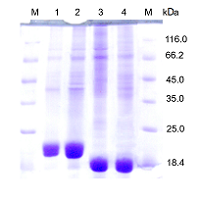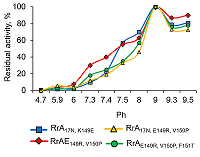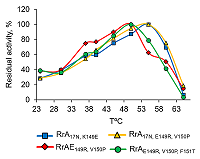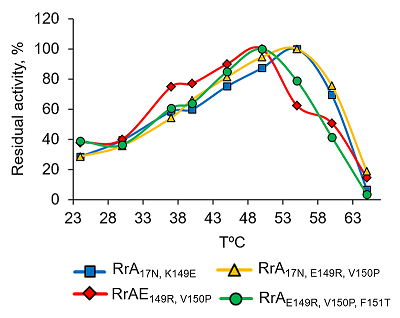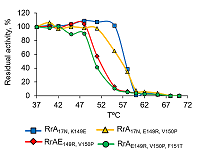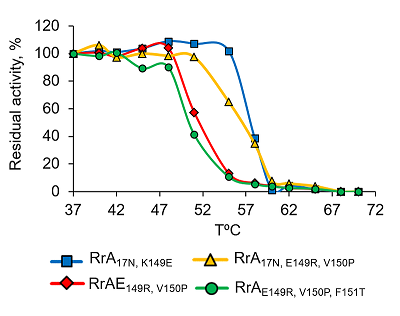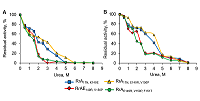Physical-Chemical Properties of L-asparaginase Mutants from Rhodospirillum Rubrum which Showed Antitelomerase Activity
1Institute of Biomedical Chemistry, 10 Pogodinskaya str., Moscow, 119121 Russia; *e-mail: ivan1190@yandex.ru
2Рeoples Friendship University of Russia, 6 Miklukho-Maklaya str., Moscow, 117198 Russia
3Research Center of Biotechnology RAS, 33 Leninsky Prospect, Moscow, 119071 Russia
Keywords: L-asparaginase Rhodospirillum rubrum; site-directed mutagenesis; physical-chemical properties
DOI:10.18097/BMCRM00071
Rru_A3730 protein is a bacterial Rhodospirillum rubrum L-asparaginase (RrA), which is known by its anticancer activity. RrA variants with point amino acid substitutions in the region of 150 amino acids residues: RrAN17,K149E, RrAE149R,V150P,F151T, RrАN17,E149R,V150P, RrAE149R,V150P, showed antiproliferative properties, and also by their ability to suppress telomerase activity. This work is devoted to comparison of physical-chemical and catalytic properties of these mutant forms of RrA. It is shown that pH optimum is in the alkaline zone (8.5 – 9.3); L-glutaminase and D-asparaginase activity is respectively not more than 0.1% and 1.6% of L-asparaginase for all studied variants of RrA. The presence of the N17-terminal amino acid sequence MASMTGGQMGRGSSRQ of the capsid protein of bacteriophage T7 in the RrA structure leads to an increase in the thermal stability of mutant RrA analogues (from 50°C to 56°C) and their resistance to denaturation in the presence of 3 – 4 M urea. It is of Metal ions exhibit multidirectional effects on L-asparaginase activity of RrA. K+, Ca2+, Zn2+, Cs+, Co2+ in significantly affect the activity of L-asparaginase, while Mn2+, Cu2+, Fe3+ ions inhibit it. There was no correlation between antitelomerase (antiproliferative) activity and kinetic properties of mutant forms of L-asparaginase RrA.


|
Figure 2.
Dependence activity of L-asparaginase RrA variants on the ionic strength in 0.1 M Na-phosphate buffer pH 7.4 (A) and in 0.01 M NaHCO3 buffer pH 7.4 (B).
|
|
CLOSE

|
Table 1.
Influence of metal ions and some reagents on the L-asparaginase activity of RrA mutant forms.
|
ACKNOWLEDGEMENTS
The authors express their deep gratitude to PhD Natalia F. Belyaeva (research Institute of biomedical chemistry
V. N. Orekhovich, Russia) for participation in discussion of results and Vasily N. Lazarev (research Institute of physical and chemical medicine, Russia) for DNA sequencing.
FUNDING
The work was performed in the framework of the Program for Basic Research of the State Academies of Sciences for 2013–2020 and partially supported by Russian Foundation for Basic Research grant 15-34-70020.
REFERENCES
- Hill, J. M., Roberts, J. E., Loeb, E., Khan, A., MacLellan, A., Hill, R. W. (1967). L-asparaginase therapy for leukemia and other malignant neoplasms. Remission in human leukemia. J. Amer. Med. Ass., 202(9), 882–888.
- Oettgen, H. F., Old, L. J., Boyse, E. A., Campbell, H. A., Phillips, F. S., Clarkon, B. D., Tallal, L., Leeper, R.D., Schwartz, M.K., Kim, L.H. (1967). Inhibition of leukemias in man by L-asparaginase. Cancer Res., 27(12), 2619–2631.
- Lazarus, H., McCoy, T. A., Farber, S., Barell, E. F., Foley, G. E. (1969). Nutritional requirements of human leukemic cells. Asparagine requirements and the effect of L-asparaginase. Exp. Сell Res., 57, 134 – 138.
- . Ueno, T., Ohtawa, K., Mitsui, K., Kodera, Y., Hiroto, M., Matsushima, A., Inada, Y., Nishimura, H. (1997). Cell cycle arrest and apoptosis of leukemia cells induced by L-asparaginase. Leukemia, 11, 1858–1861.
- Ollenschläger, G., Roth, E., Linkesch, W., Jansen, S., Simmel, A., Mödder, B. (1988). Asparaginase-induced derangements of glutamine metabolism: the pathogenetic basis for some drug-related side-effects. Eur. J. Clin Invest., 18(5), 512–516.
- Offman, M. N., Krol, M., Patel, N., Krishnan, S., Liu, J., Saha, V., Bates, P. A. (2011). Rational engineering of L-asparaginase reveals importance of dual activity for cancer cell toxicity. Blood, 117(5), 1614–1621. DOI
- Blackburn E.H. (2000). Telomere states and cell fates. Nature, 408 (6808), 53–56. DOI
- Kim N. W., Piatyszek M. A., Prowse K. R., Harley C. B., West M. D., Ho P. L. C., Oviello G. M., Wright W. E., Weinrich S. L., Shay J. W. (1994). Specific association of human telomerase activity with immortal cells and cancer. Science, 266 (5193), 2011–2015.
- Marian C.O., Cho S.K., McEllin B.M., Maher E.A., Hatanpaa K.J., Madden C.J. Mickey B.E., Wright W.E., Shay J.W., Bachoo R.M. (2010). The telomerase antagonist, imetelstat, efficiently targets glioblastoma tumor-initiating cells leading to decreased proliferation and tumor growth. Clin. Cancer Res., 16(1), 154–163. DOI
- Pokrovskaya, M. V., Pokrovsky, V. S., Aleksandrova, S. S., Anisimova, N. I., Adrianov, R. M., Treshchalina, E. M., Ponomarev, G. V., Sokolov, N. N. (2012). Recombinant intracellular Rhodospirillum rubrum L-asparaginase with low L-glutaminase activity and antiproliferative effect. Biochemistry (Moscow) Supplement Series B: Biomedical Chemistry, 6 (2), 123–131. DOI
- Studier, F. W., Moffatt, B. A. (1986). Use of bacteriophage T7 RNA polymerase to direct selective high-level expression of cloned genes. J. Mol.Biol., 189(1), 113–130.
- Pokrovskaya, M. V., Aleksandrova, S. S., Pokrovsky,V. S., Veselovsky, A.V., Grishin, D. V., Abakumova, O. Yu., Podobed, O. V., Mishin, A. A., Zhdanov, D. D., Sokolov, N. N. (2015). Identification of Functional Regions in the Rhodospirillum rubrum L-Asparaginase by Site-Directed Mutagenesis. Molecular Biotechnology. Mol. Biotechnol., 57(3), 251–264.
- 10.1007/s12033-014-9819-0
- Pokrovsky,V.S., Anisimova, N.Yu., Pokrovskaya, M.V., Alexandrova, S.S., Sokolov, N.N., Treschalina, E.M. Antiproliferative activity of recombinant l-asparaginase Rhodospirillum rubrum. J. of N. N. Blokhin RCRC 4(22)24-31.
- Pokrovskaya, M. V., Zhdanov, D. D., Eldarov, М. А., Aleksandrova, S. S., Veselovsky, A. V., Pokrovsky, V. S., Grishin, D. V., Gladilina, Y. А., Sokolov, N. N. (2017). Suppression of telomerase activity in leukemic cells by mutant forms of Rhodospirillum rubrum L-asparaginase. Biochemistry (Moscow), Supplement Series B: Biomedical Chemistry, 11(3), 219–233. DOI
- Sanger, F., Nicklen, S., Coulson, A. R. (1977). DNA sequencing with chain-terminating inhibitors. Proceedings of the National Academy of Sciences, 74(12), 5463–5467.
- Sedmak, J. J., Grossberg, S. E. (1977) A rapid, sensitive, and versatile assay for protein using coomassie brilliant blue G250. Anal. Biochem., 79(1), 544–552.
- Laemmli, U.K. (1970) Cleavage of Structural Proteins During the Assembly of the Head of Bacteriophage T4. Nature, 227, 680–685.
- Wriston, J. C., Yellin, T. O. (1973). L-Asparaginase: a review. Advances in Enzymology and Related Areas of Molecular Biology. Adv. Enzymol. 39, 185–248.
- Gaffar, S. A., Shethna, Y. I. (1977). Purification and some biological properties of asparaginase from Azotobacter vinelandii. App. and Environmental Microbiol., 33(3), 508–514.
- Maggi, M., Chiarelli, L. R., Valentini, G., Scotti, C. (2015). Engineering of Helicobacter pylori L-Asparaginase: Characterization of Two Functionally Distinct Groups of Mutant. PLoS One 10(2); e0117025. DOI
- Derst, C., Henseling, J., Rohm, K. H. (2000). Engineering the substrate specificity of Escherichia coli asparaginase. Selective reduction of glutaminase activity by amino acid replacements at position 248. Protein Sci. 9(10), 2009–2017. DOI
- Distasio, J. A., Salazar, A. M., Nadji, M., Durden, D. L. (1982). Glutaminase-free asparaginase from vibrio succinogenes: an antilymphoma enzyme lacking hepatotoxicity. Int. J. Cancer. 30(3), 343–347.
- Goswami, R., Hegde, K., Veeranki, D. V. (2014) Batch, Fed Batch Producnion and Characterization of Glutaminase free L-Asparaginase 11 of Pectobacterium carotovorum MTCC1428 in Esherichia coli. Adv. Microbiology, 4(10), 667–680. DOI
- Bansal, S., Gnaneswari, D., Mishra, P., Kundu, B. (2010) Structural stability and functional analysis of L-asparaginase from Pyrococcus furiosus. Biochemistry (Moscow), 75(3), 375–381.
- Pokrovsky, V.S., Pokrovskaia, M.V., Aleksandrova, S.S., Andrianov, R.M., Zhdanov, D.D., Omel'ianiuk, N.M., Treshchalina, E,M,, Sokolov, N.N. (2013). Physico-chemical properties and antiproliferative activity of recombinant Yersinia pseudotuberculosis L-asparaginase. Prikl. Biokhim. Mikrobiol. 49(1), 24-28.
- Jia, M., Xu, M., He, B., Rao, Z. (2013). Cloning, expression and characterization of L-asparaginase from a newly isolated Bacillus subtilis B11-06. J. Agric. Food Chem. 61, 9428–9434. DOI
- Libinson, G. S., Mikhalev, A. V. (1976). Relationship betweenthe magnitude of Km and pH for L-asparaginase. Biochemistry, 41(1), 149–152.
- Moreno-Enriquez, A., Evangelista-Martinez, Z., Gonzalez-Mondragon, E. G., Calderon-Flores, A., Arreguin, R., Perez-Ruedas, E., Huerta-Saquero, A. (2012). Biochemical Characterization of Recombinant L-Asparaginase (AnsA) from Rhizobium etli, a Member of an Increasing Rhizobial-Type Family of L-Asparaginases. J. Microbiol. Biotechnol., 22(3), 292–300.
- Mahajan, R. V., Kumar, V., Rajendran, V., Saran, S., Ghosh, P. C., Saxena, R. K. Purification and characterization of a novel and robust L-asparaginase having low-glutaminase activity from Bacillus licheniformis: in vitro evaluation of anti-cancerous properties. (2014). Plos One, 9(6) e99037.
- Borek, D., Kozak, M., Pei, J., Jaskolski, M. (2014). Producnion and characterization of glutaminase free L-Asparaginase 11 of Pectobacterium carotovorum MTCC1428 in Esherichia coli. FEBS Journal Special Issue: Celebrating the International Year of Crystallography, 281(18), 4097–4111. DOI
- Hethey, J., Lai J., Loutet, S., Martin, M., Vincent, T. (2002). Effects of Tricine, Glycine and Tris Buffers on Alkaline Phosphatase Activity. J. Exp. Microbiology and Immunology, 2, 33–38.
- Gervais, D., Foote, N. (2014). Recombinant deamidated mutants of Erwinia chrysanthemi L-asparaginase have similar or increased activity compared to wild-type enzyme. Mol. Biotechnol., 56(10), 865–877. DOI
- Sanches, M, Krauchenco, S., Polikarpov, I. (2007). Structure, substrate complexation and reaction mechanism of bacterial asparaginases. Current Chemical Biology, 1(1), 75–86. DOI
- Cedar, H., Schwartz, J. H. (1968). Localization of the two L-asparaginases in anaerobically grown Escherichia coli. J. Biol. Chem., 242, 3753–3755.
